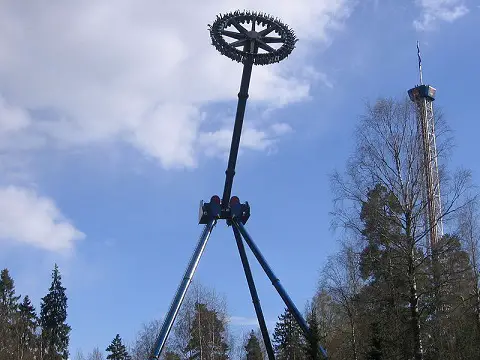| Back to Back Issues Page |
 |
|
Real World Physics Problems Newsletter - Amusement Parks, Issue #09 July 16, 2014 |
Amusement Parks
https://www.real-world-physics-problems.com/images/frisbee_ride.jpg Source: Wikipedia via SpinSpider
I am currently working on an amusement park physics page and all I can say is, wow, there is so much out there. All amusement park rides are based on classical mechanics since they all deal with forces, energy, and Newton's laws, but the sheer number of different rides that exist is what makes this such a huge undertaking. If you want to see all the rides that are available check out this list of amusement park rides. No doubt it will take me a while to go through it all, but in my efforts so far I did gain some interesting insights about amusement park rides in general. All rides cause you to experience acceleration by way of the rides' motion. It is the magnitude and direction of this acceleration that causes you to experience a certain amount of g-force (as is commonly called) as you sit on the ride. A g-force of "1" is your body weight. A g-force of "2" is twice your body weight, and so on. Naturally, the higher the g-force the more "pressure" your body feels. Ride designers want the riders to have as much fun as possible without generating excessive g-force, which can be dangerous. One way to do this is by making the radius of turns, such as on roller coasters, large enough to keep the g-force, caused by centripetal acceleration, within a reasonable range. Another way is to make different parts of the rides turn in opposite directions. For example, in the Zamperla balloon ride shown below, the main wheel spins in the direction opposite to the direction of precession.
https://www.youtube.com/watch?v=rSZzXQgmFiw
Roller coasters, on the other hand, can produce some serious g-forces, as much as 3-6g. There are many types of ride designs consisting of all sorts of interesting geometry and motion, and some of them look downright scary. The Ultramax ride shown below is one of the scarier looking rides. It is essentially a giant rotating pendulum. Check it out. And if you're feeling brave try one out sometime.
https://www.youtube.com/watch?v=lPGSR58XTuU
|
| Back to Back Issues Page |
